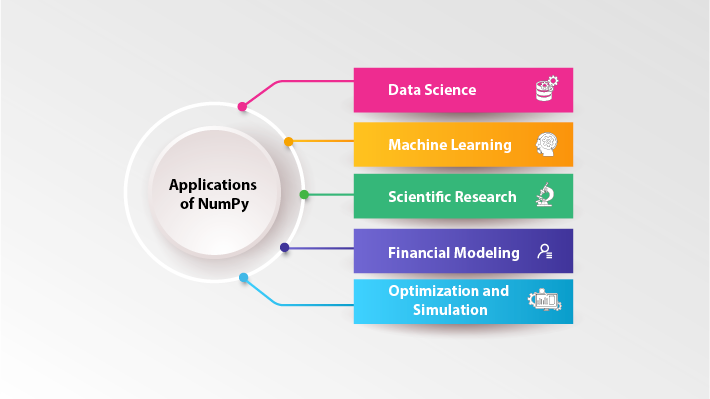Table of Contents
ToggleIntroduction
Python’s versatility as a programming language needs no introduction. It has been ranked as the most popular programming language in 2023 on the TIOBE Index and the PYPL Index. With comprehensive frameworks and libraries such as TensorFlow, Flask, Django, NumPy, Hadoop, and PyTest, Python is a programming language with limitless applications. In this blog, we will look at NumPy, a Python library that helps with high-level mathematical functions.

Don't miss out on your chance to work with the best
apply for top global job opportunities today!
Must Read: Django in Python
What is NumPy?
If you are looking for a fundamental package for numerical and scientific computation, NumPy is the answer. Numerical Python, commonly known as NumPy, is a Python library with a huge collection of high-level mathematical functions. It was created in 2005 and is an open source Python programming library that simplifies the process of numerical computing.
With an active community of around 700 contributions and more than 18,000 comments on GitHub, NumPy is a great package for general-purpose array processing. It provides developers with arrays, which are high-performance multidimensional objects. In addition, the problem of slow speed is also addressed through these arrays and operators that work efficiently on these arrays.
You can install NumPy by running this command in your terminal:

NumPy Versions
| Release | Released | Security Support | Latest |
|---|---|---|---|
| 1.26 | 16 Sep 2023 | Ends on 17 Sep 2025 | 1.26.3 (02 Jan 2024) |
| 1.25 | 17 Jun 2023 | Ends on 18 Jun 2025 | 1.25.2 (31 Jul 2023) |
| 1.24 | 18 Dec 2022 | Ends on 19 Dec 2024 | 1.24.4 (26 Jun 2023) |
| 1.23 | 22 Jun 2022 | Ends on 24 Jun 2024 | 1.23.5 (20 Nov 2022) |
| 1.22 | 31 Dec 2021 | Ended on 01 Jan 2024 | 1.22.4 (20 May 2022) |
| 1.21 | 22 Jun 2021 | Ended on 23 Jun 2023 | 1.21.6 (12 Apr 2022) |
Features of NumPy

Powerful N-Dimensional Arrays
NumPy’s N-dimensional array object, numpy.ndarray, helps write exceptional arrays. These arrays can efficiently store and manipulate large datasets and are homogeneous. This function allows users to work with a wide dimension of arrays and makes it well-suited for various scientific computing tasks.
Numerical Computing Tools
The rich set of numerical computing tools and functions offered by NumPy helps perform operations on arrays. In addition, NumPy has mathematical functions that help with tasks like array manipulation, linear algebra, Fourier analysis, and statistical operation. The numerical computing tools make complex numerical operations easy, making NumPy a go-to library for scientific computing.
Open Source
NumPy is an open-source library released under the BSD license. Users can freely use, modify, and distribute the library’s source code. As it is open source, it encourages collaboration and contributions from the community, which fosters continuous improvement and innovation.
Interoperable
NumPy is interoperable with other libraries and tools in the Python ecosystem. In other words, it integrates seamlessly with libraries like SciPy (scientific computing), Matplotlib (data visualization), pandas (data manipulation), and scikit-learn (machine learning). This creates a comprehensive environment for scientific and data analysis tasks.
Performant
NumPy is highly efficient for numerical operations as it is implemented in C and Fortran. The core functionality of NumPy is written in low-level languages. Because of this, large dataset operations can be executed efficiently. This makes NumPy highly recommendable for scientific computing applications where speed is often a critical factor.
Easy to Use
NumPy has a clear and intuitive syntax, which makes it user-friendly. Moreover, its array-oriented computing paradigm makes code readability simple and reduces the need for explicit looping over elements. The simplicity and consistency of NumPy’s API make it easy to use and accessible for both beginners and experienced developers.
What are the Applications of NumPy?

As an open source Python library, NumPy is used in almost every field that works with numbers. Let’s look at the domains where NumPy is widely used.
Data Science
Data scientists handle many numerical analyses and functions daily. In the context of data science, NumPy offers the simplicity of C and Fortran to Python. With Python, you can create and work with arrays, return descriptive statistics, and work on a variety of machine-learning models and mathematical formulas.
With extensive functionalities that provide tools for data preprocessing, manipulation, and analysis, NumPy is also popular as the backbone of other data science libraries like Pandas, Matplotlib and Scikit-learn.
Machine Learning
Mathematics is the foundation of many machine learning tasks, and NumPy helps you perform many of these tasks. Powerful machine learning libraries like Scikit-learn and SciPy, as well as deep learning libraries such as PyTorch, are based on NumPy. With NumPy, it is possible to handle data manipulation effectively and efficiently.
Not only this, the NumPy library is also a very useful tool for studying Machine Learning. You can learn how to:
Scientific Research
The scientific research community consists of data scientists, researchers and engineers who work with a lot of simulations, modeling, and data analysis in their field. NumPy has a powerful array and matrix processing framework and collection of mathematical functions for scientific research. Here are some of the ways in which NumPy can be extensively used in scientific research:
- Data Representation
- Numerical Computations
- Statistical Analysis
- Interdisciplinary Research
- Integration with Other Scientific Libraries
- Engineering and Signal Processing
Financial Modeling
Financial technology is a vast field that is witnessing rapid upgrades and progress. NumPy is one of the most useful Python packages for Finance, as it helps a great deal with programming tasks like:
- Data importation and transformation
- Time series and risk analysis
- Trading and backtesting
- Excel integration
- Data visualization
The quantitative finance applications of NumPy have the framework for financial models to carry out operations to crunch numbers and manipulate data structures.
Optimization and Simulation
NumPy’s efficient array operations and mathematical functions make it a widely used library for optimization and simulation. Here are a few ways how NumPy can be used in optimization and simulation:
- Mathematical Optimization: The ‘numpy.optimize’ module contains algorithms such as BFGS, Nelder-Mead, and constrained optimization methods.
- Linear Programming: NumPy helps with optimizing a linear objective function subject to linear equality and inequality constraints.
- Non-linear Optimization: NumPy interfaces with optimization algorithms in the scipy.optimize module. These algorithms are capable of handling unconstrained and constrained optimization with various techniques.
- Curve Fitting: NumPy helps find the best-fit parameters for a given mathematical model based on observed data. The numpy.polyfit function is commonly used for polynomial curve fitting.
- Monte Carlo Simulations: Monte Carlo methods use random sampling to model the behavior of complex systems. NumPy’s random number generation capabilities are crucial for simulating random events and outcomes.
- Queueing Systems: NumPy helps with simulation of queueing systems in operations research. This includes modeling the arrival and departure of entities in a queue to analyze system performance.
- Game Theory Simulations: NumPy’s array operations and random number generation help in building simulations for game theory scenarios.
- Population Dynamics: Logistic growth models used to study population dynamics and in ecology and biology can be simulated using NumPy.
Take control of your career and land your dream job
sign up with us now and start applying for the best opportunities!

Conclusion
The significance of NumPy is evident in its wide range of applications spanning across diverse domains. As a fundamental package for numerical and scientific computation, NumPy is extensively used in fields such as data science, financial modeling, machine learning and scientific research. NumPy’s key features make it a powerful tool to simplify the complexities of numerical computing. As a programmer navigating through the ever-expanding landscape of Python libraries, NumPy is an indispensable tool that facilitates your Python programming journey.
FAQs
NumPy is a Python library and is written partially in Python. However, the parts that require fast computation are written in C or C++.
NumPy is not a built-in library in Python. You have to externally install it as per the requirement of your operating systems.
An ndarray (N-Dimensional array) is a multidimensional container that stores similar elements. Ndrrays have a fixed size, which is defined at the time of creation.
NumPy arrays are faster and memory efficient for numerical operations compared to lists.


